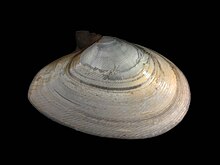Tellina fabula
| Fabulina fabula | |
|---|---|
 |
|
| Scientific classification | |
| Kingdom: | Animalia |
| Phylum: | Mollusca |
| Class: | Bivalvia |
| Subclass: | Heterodonta |
| Order: | Veneroida |
| Family: | Tellinidae |
| Genus: | Fabulina |
| Species: | F. fabula |
| Binomial name | |
|
Fabulina fabula (Gmelin, 1791) |
|
| Synonyms | |
|
Angulus fabula (Gmelin, 1791) |
|
Angulus fabula (Gmelin, 1791)
Fabulina fabuloides Monterosato, 1884
Tellina (Fabulina) fabula Gmelin, 1791
Tellina discors Pulteney, 1799
Tellina fabula Gmelin, 1791
Tellina fabuliformis Locard, 1886
Tellina fabulina Locard, 1886
Tellina fragillissima Hanley, 1843
Tellina vitrea Gmelin, 1791
The Bean-like Tellin, Fabulina fabula is a species of marine bivalve mollusc in the family Tellinidae. It is found off the coasts of north west Europe where it lives buried in sandy sediments.
Bivalves are molluscs with a body compressed between two usually similar shell valves joined by an elastic ligament. There are teeth at the edge of the shell and the animal has a muscular foot, gills, siphons, mouth and gut and is surrounded by a mantle inside the shell.
The shell of Fabulina fabula is brittle and flattened and grows to a length of twenty millimeters. The outline is oval but the shell is asymmetric with the hinge slightly off centre and the beaks slightly behind the midline. The anterior dorsal margin curves gently and the anterior margin is rounded. The posterior dorsal margin is straighter and the posterior margin is somewhat pointed. The periostracum is transparent and glossy and the shell is white with tinges of yellow or brown. There is a sculpture of fine concentric lines on both valves and some faint radial ribs on the right valve only. The inner surface of the valves is white, sometimes tinted with yellow or orange. The mantle is white with a fringe of tentacles and the gills are unequal in size.
F. fabula occurs off the coasts of north west Europe and Morocco and in the Mediterranean Sea and the Black Sea. It is found from low water level to a depth of about forty metres. In a study off the Belgian coast in 2006, this species was found at a maximum density of over a thousand individuals per square metre.
F. fabula burrows in clean or slightly muddy sand and has a large foot and two long siphons which it extends to the surface of the sediment. The longer one gropes around for organic debris which is drawn down to the mollusc through this siphon while water is expelled through the other. It is both a deposit and a filter feeder.
...
Wikipedia
